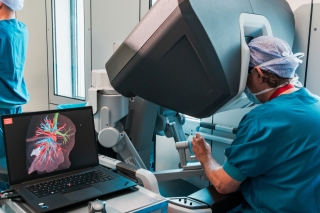Operating with VR: 'Erasmus MC Can't Do Without'
Translated from Dutch
Original author: Thijs Baas
Virtual reality has been applied in surgery for about six years now, with increasing success. At Erasmus MC, 3D models are created almost daily based on CT scans, leading to significantly more accurate interpretations of the scans, says Dr. Alexander Maat, a heart and lung specialist at the Rotterdam hospital.
Listen to the interview here (in Dutch)
The process essentially consists of two parts. Before surgery, surgeons review the CT scans, allowing them to select the key structures and go through all the steps they will perform during the operation using a VR headset. Then, as Chris Hordijk, founder and CEO of MedicalVR, explains, a laptop accompanies them into the operating room. "Our models are displayed on that laptop, allowing them to adjust the lung to the anatomy of the moment."
"We Can't Do Without It," - Alexander Maat, Erasmus MC
Described as a kind of Google Maps or TomTom for doctors, Maat has used this simulation this morning. Although he has little insight into other hospitals, he is already convinced of the technology. "We can't do without it," he says. "Several Dutch centers are involved in a study in various hospitals to further support the value of this technology with larger numbers."
Center of the Lungs
Maat believes the technology can be applied in various other areas as well. It is already happening in brain and abdominal surgery. "I think the applications are almost endless." Situations during surgery that cannot be captured in a 3D model are extremely rare, says Maat. "We focus on the center of the lungs, and most errors occur on the outside of the lungs. Errors in the crucial part of the lung are incredibly rare."
A new phase seems to have arrived with the recent introduction of the Apple Vision Pro. Hordijk has already given hundreds of demos with other VR headsets, but he believes this one is of a different order. "Apple has really done an excellent job of ensuring that the user experience is top-notch: people put on the glasses and immediately understand what they need to do—the onboarding and interaction: it will soon be possible for multiple people to view the same model."
Technical Challenges
Then there is the privacy aspect, where Apple does not always have a pristine reputation. According to Hordijk, it is crucial to comply with GDPR, and this is extensively coordinated with privacy security officers from the hospitals themselves. But it is clear that the data used have already been stripped of patient metadata, such as address, age, and name. The challenges are mainly technical. "It's mainly about being able to deploy technology that meets the speed of the user."
That speed is crucial, especially in a medical environment. Currently, a doctor uploads a CT scan to the cloud platform, after which they receive the result two days later. "We prefer local, so we are now also running the AI algorithms locally, so it can be done within ten minutes instead of two days." The next step is communication with heart failure patients. "Currently, a drawing is made on a piece of paper. With this technology, the cardiologist sees what he sees on the VR headset."
What to Expect
And then there is the training application. Operating rooms are often the most expensive places to learn, and with these devices, it is very easy to practice at home or anywhere else and become proficient in what to expect in the operating room: the sounds, steps, actions, but also seeing what else you can learn. "It's especially important that the students you put there come in at a very high level."
source: BNR Nieuwsradio
Foto: (ANP / marlieswessels.nl)
